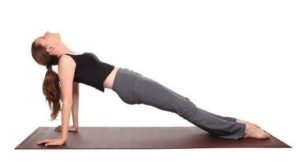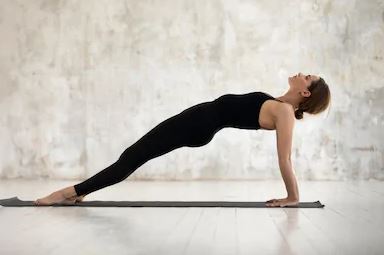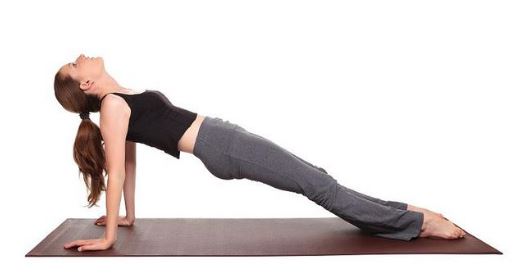Purvottanasana, Inclined Pose or Upward Plank Pose has many names. Its also called Reverse Plank, Back Bend or Upward Plane. Purvottanasana a Sanskrit word from where it derives its meaning = Intense stretch of the front portion of the body.
The most commonly used names are Purvottanasana, Inclined Pose or Upward Plank Pose (to be used throughout this article).
It comes right after the Pascimottanasana or Sitting Forward Bend Yoga Pose out of the 12 Basic Yoga Poses or Asanas. It is the 5th Pose in the Sequence of the 12 Basic Yoga Poses for Beginners.
What is Purvottanasana Pose in Yoga?
Purvottanasana, Inclined Pose or Upward Plank Pose is an important counterpose to the forward bend.
Purvottanasana is a Sanskrit word divided into four parts:
Purva = East
Ut = Intense
Tan = Stretch
Asana = Pose or Posture
Thus, it literally means “East facing Intense Body Stretch”. This Yoga Pose can be performed by all age groups and any gender. It is a very popular Yoga Asana for beginners.
Purvottanasana, Inclined Pose or Upward Plank Pose is helpful in improving a sense of balance, strengthens your back, wrist, arm and leg muscles. Moreover, it is a highly recommended Basic Yoga Pose to prepare you for Headstand where your weight rests on your arms.
How to do Purvottanasana, Inclined Pose or Upward Plank Pose?
For optimal flexibility in all muscles, you need both strength and length. Therefore, after you have stretched your muscles in the back by forwarding stretches it is a must for you to contract the same muscles to make them stronger.
Purvottanasana, Inclined Pose or Upward Plank Pose is also a counterpose to the Forward Bend Pose. It improves your sense of balance, makes your arms, legs and back stronger.
Basic Steps to do Purvottanasana, Inclined Pose or Upward Plank Pose
Please follow each and every step along with breathing instructions as you perform Purvottanasana, Inclined Pose or Upward Plank Pose.

Step 1:
When you sit on the Yoga mat with your legs stretched out straight, place your hands flat on the floor 1 feet behind you with your fingers pointing backwards. Lean a little bit backwards on your hands. Next, take a few deep breaths and then Inhale.
Tip: If you find it uncomfortable to place the fingers pointing behind, it is also okay to keep your palms on the yoga mat with fingers pointing forwards. However, once you gain strength in your wrists and arms – try and point your fingers backwards as in Image 1 to achieve the correct posture for best results.
See Image Below:

Step 2:
Next, drop your head back and try and bring your should blade together. Make sure your mouth is closed.
Step 3:
Then, Exhale and lift your hips upwards as much as possible. (See Image above). Also, try and bring your feet flat on the Yoga mat, with your feet together. Remember, that your feet should not turn outwards. Moreover, keep your knees straight. If you are a beginner you may hold this pose only for a maximum of 10 seconds. As you advance aim to stay in this basic Yoga Asana for 1 minute. When you are Holding the Pose – keep breathing deeply in and out.
Most importantly, hold this Pose for a count of 4 or for a length of 2-3 breaths or even longer as per your comfort.
Step 4:
To come out of the Pose come back on the Yoga mat gently without any jerks when you sit down. Shake your wrists – as your body pressure was on them during the Yoga Pose. Also, stretch your arms straight out in front of you and roll down to lie on your back in a Corpse Pose or Shavasana. See Image Below:
Corpse Pose in Yoga (Savasana or Shavasana) Steps and Benefits
How long do you hold the Pose?
Try to hold this Pose for a count of 4 or for 2-3 breaths as per your comfort. Moreover, when you are Holding the Pose – keep breathing deeply in and out.
After completing the Purvottanasana, Inclined Pose or Upward Plank – you should relax on your abdomen.
Common faults while doing Purvottanasana, Inclined Pose or, Upward Plank Pose
Most Common faults made by beginners who have not been trained by a certified Yoga Trainer to do Purvottanasana, Inclined Pose or, Upward Plank Pose – are:
- Firstly, your head is kept forward rather than letting it hang backwards.
- Secondly, there is tension in the neck and shoulders while performing the task.
- Hips are not raised – and have swayed on one side or are rotated.
- Any of the knees may bend.
- hands are not straight and rotated outwards. make sure the fingers point away from your backwards.
- Feet are not straight but turned outwards. Therefore, if this happens your hips, body and back will be non-aligned. Make sure, your legs should be kept close to each other.
CAUTION
Beginners practising Purvottanasana, Inclined Pose or Upward Plank Pose – you may experience foot cramps at the very initial stage of performing this Yoga Pose. In case you feel a cramp coming – come down on your hips in a sitting position, breathe deeply and massage the foot and move it until it has subsided.
Benefits of Purvottanasana, Inclined Pose or, Upward Plank Pose
- Your chest gets expanded as you do the Purvottanasana, Inclined Pose, or, Upward Plank. Expanding your lungs and inhaling more oxygen.
- The entire length of your body is gently given a backward bend.
- It enhances your balance and muscular co-ordination.
- Lastly, Purvottanasana, Inclined Pose or Upward Plank – strengthens arms, shoulders, wrists, hip increasing their flexibility.
Do let us know if you tried Purvottanasana, Inclined Pose or Upward Plank Pose in Yoga and how has it benefitted you.
Related Articles:
Feel-Good Short Motivational Story of a Young Boy
What is the Best time to do Headstand?
6 Yoga Poses for Digestion and Bloating
Do’s and don’ts of Yoga during Pregnancy
What to do before you start Yoga – to prepare yourself?
10 Questions Answered for Beginners doing Yoga Poses








